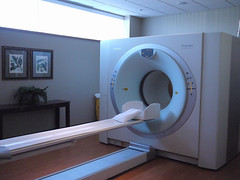| 5284990048 | Lesion | Tissue destruction. Naturally or experimentally caused destruction of the brain tissue. |  | 0 |
| 5284990049 | Electroencephalogram(eeg) | An amplified recording of the waves of electrical activity sweeping across the brains surface. These waves are measures by the electrodes placed on the scalp. |  | 1 |
| 5284990050 | Ct(computed tomography) scan | A series of x Ray photographs taken from different angles and combined by a computer into a composite representation of a slice of the brains structure(also called CAT scan) |  | 2 |
| 5284990051 | Pet(positron emission tomography) scan | A visual display of the brain activity that detects where a radioactive form of glucose goes while the brain performs a given task. |  | 3 |
| 5284990052 | Mri(magnetic resonance imaging) | A technique that uses magnetic fields and radio waves to produce computer generated images of soft tissue. These scans show brain anatomy. |  | 4 |
| 5284990053 | Fmri(functional mri) | A technique for revealing blood flow, and therefore, brain activity by comparing successive MRI scans. These scans show brain function as well as its structure. |  | 5 |
| 5284990054 | Brainstem | The oldest part and central core of the brain, beginning where the spinal cord swells as it enters the skull; the brainstem is responsible for automatic survival functions. |  | 6 |
| 5284990055 | Medulla | The base of the brainstem; controls heartbeat and breathing. |  | 7 |
| 5284990056 | Thalamus | The brains sensory control center, located on top of the brainstem; it directs messages to the sensory receiving areas in the cortex and transmits replies to the cerebellum and medulla. |  | 8 |
| 5284990057 | Reticular formation | A nerve network that travels through the brain system and thalamus and plays an important role in controlling arousal: |  | 9 |
| 5284990058 | Cerebellum | The "little brain" at the rear of the brainstem; functions include processing sensory input, coordinating movement output and balance, and enabling nonverbal learning and memory. |  | 10 |
| 5284990059 | Limbic system | Neural system( including the hippocampus, amygdala, and hypothalamus) located below the cerebral hemispheres; associated with emotions and drives. |  | 11 |
| 5284990060 | Amygdala | Two lima bean sized neural clusters in the limbic system; linked to emotion. |  | 12 |
| 5284990061 | Hypothalamus | A neural structure lying below the thalamus; it directs several maintenance activities( eating, drinking, body temperature), helps govern the endocrine system via the pituitary gland and is linked to emotion and reward. |  | 13 |
| 5284990062 | hippocampus | A neural center located in the limbic system that helps process explicit memories for storage. |  | 14 |
Ap psychology module 11 Flashcards
Primary tabs
Need Help?
We hope your visit has been a productive one. If you're having any problems, or would like to give some feedback, we'd love to hear from you.
For general help, questions, and suggestions, try our dedicated support forums.
If you need to contact the Course-Notes.Org web experience team, please use our contact form.
Need Notes?
While we strive to provide the most comprehensive notes for as many high school textbooks as possible, there are certainly going to be some that we miss. Drop us a note and let us know which textbooks you need. Be sure to include which edition of the textbook you are using! If we see enough demand, we'll do whatever we can to get those notes up on the site for you!

